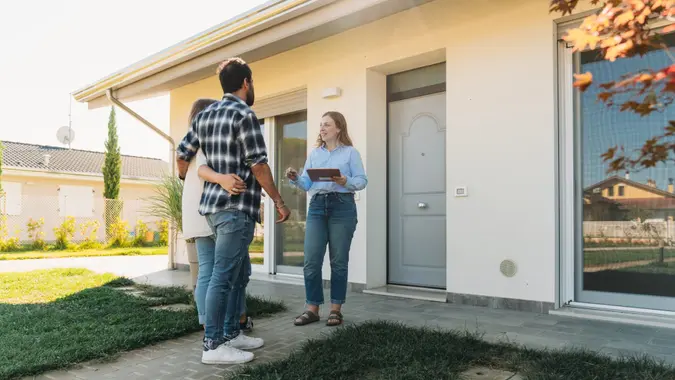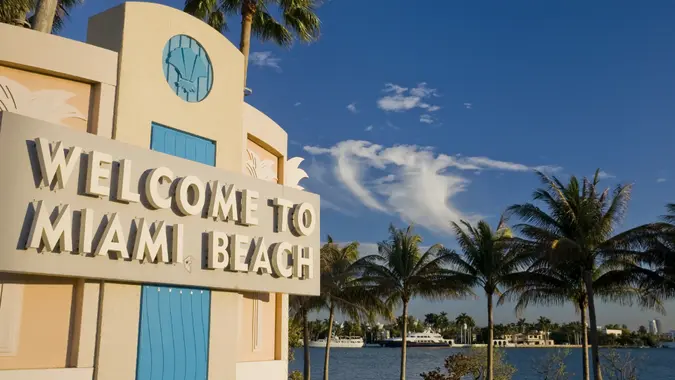What Does Pre-Foreclosure Mean and How Does It Work?

Commitment to Our Readers
GOBankingRates' editorial team is committed to bringing you unbiased reviews and information. We use data-driven methodologies to evaluate financial products and services - our reviews and ratings are not influenced by advertisers. You can read more about our editorial guidelines and our products and services review methodology.

20 Years
Helping You Live Richer

Reviewed
by Experts

Trusted by
Millions of Readers
If you’re falling behind on mortgage payments — or thinking about buying a distressed property — you may be wondering: What does pre-foreclosure mean? Simply put, pre-foreclosure is the early warning stage in the foreclosure process when a homeowner is behind on payments but hasn’t yet lost the home.
This phase is critical for both homeowners and buyers. If you’re a homeowner, it’s your last chance to take action and avoid foreclosure. If you’re a buyer, it could be your opportunity to purchase a home at a discount — if you know where to look.
What Exactly Is Pre-Foreclosure?
Pre-foreclosure begins when a homeowner misses several mortgage payments and the lender issues a notice of default. The homeowner still legally owns the property, but the clock starts ticking toward foreclosure unless something changes fast.
So, what’s the key difference between pre-foreclosure and foreclosure?
- In pre-foreclosure, the owner still has time to fix the situation.
- In foreclosure, the lender has taken steps to repossess and sell the home.
Why Do Homes Go Into Pre-Foreclosure?
Most pre-foreclosure cases begin when a homeowner misses three or more payments. But there are usually deeper financial challenges behind it.
Common Reasons Include:
- Job loss or income reduction
- Unexpected medical bills or family emergencies
- Divorce or separation
- High adjustable mortgage rates resetting higher
In 2023, over 357,000 U.S. properties received foreclosure filings, according to ATTOM — many of those began with a pre-foreclosure notice.
What Are a Homeowner’s Options in Pre-Foreclosure?
Being in pre-foreclosure doesn’t mean you’re out of options. This is the window to take control.
Here’s what you can do:
- Catch up on missed payments: If you can pay the full past-due amount (plus fees), you can stop the process entirely.
- Request a loan modification: Lenders may agree to adjust the terms so that payments become more affordable.
- Refinance the mortgage: If you qualify, refinancing might reduce your interest rate or extend the loan term.
- Sell the home before foreclosure: Selling can help you avoid foreclosure and protect your credit.
- Explore a short sale: If your home is underwater, a short sale may allow you to sell it for less than what you owe, with lender approval.
Tip: The earlier you communicate with your lender, the more likely you are to find a workable solution.
How Buyers Can Find Pre-Foreclosure Properties
Looking to buy a pre-foreclosed home? These properties can be priced below market value, but they come with some extra steps.
Where to Find Listings:
- County court and public records
- Online foreclosure databases (like RealtyTrac or Zillow Pre-Foreclosures)
- HUD’s website
- Real estate agents who specialize in distressed properties
What to Watch For:
- Homes may be sold “as-is”, with little room for negotiation or repairs.
- There may be legal hurdles or back taxes tied to the property.
- It often takes longer to close a deal.
Pre-foreclosure buyers may pay 5 to 10% below market price, depending on the home’s condition and location.
Legal and Financial Consequences for Homeowners
Credit Impact
Missing mortgage payments can cause a credit score drop of 100 points or more. A full foreclosure is worse and can stay on your credit report for up to seven years.
Homeowner Rights
During pre-foreclosure, you still own your home. You can:
- Sell it
- Pay off the overdue amount
- Negotiate new terms
- Walk away with a short sale (if approved)
Know Your State Laws
Some states are judicial (require court involvement), while others are non-judicial. This affects how long you have and how the process plays out.
How To Avoid Pre-Foreclosure in the First Place
Preventing pre-foreclosure is all about being proactive before things spiral.
Here are some smart steps:
- Build an emergency savings fund to cover 3-6 months of expenses
- Call your lender early if you’re struggling–don’t wait
- Ask about forbearance or hardship assistance
- Meet with a HUD-approved housing counselor for free help
You can learn more about HUD’s housing programs online or via their counseling hotline at 1-800-569-4287.
Final Take to GO: What Pre-Foreclosure Means for You
So, what does pre-foreclosure mean in real life? It’s a serious financial warning, but not a final sentence. For homeowners, it’s a chance to take control and explore solutions. For buyers, it may present an opportunity — if you’re prepared to handle the complexities.
Key Takeaways:
- Pre-foreclosure happens before foreclosure officially begins.
- Homeowners still have time to resolve the issue.
- Buyers can potentially find deals, but should proceed carefully.
Whether you’re trying to stay in your home or considering buying one in pre-foreclosure, understanding the process helps you make smarter choices.
Want to learn more about saving your home or buying real estate? Check out:
FAQs: Pre-Foreclosure Explained
Here are the answers to some of the most frequently asked questions about pre-foreclosure and how it works:- How long does pre-foreclosure last?
- Usually between 3 to 6 months, depending on your lender and state laws.
- Can I stop pre-foreclosure once it starts?
- Yes -- by catching up on payments, refinancing or selling your home.
- Does pre-foreclosure hurt your credit?
- Yes. Even before foreclosure, missed payments can lower your score significantly.
- Is it a good time to buy during pre-foreclosure?
- It can be, but you’ll need to do more homework than with a regular sale.
- What’s the difference between pre-foreclosure and foreclosure?
- Pre-foreclosure means you’re behind but still have options. Foreclosure is the legal process of the lender taking the home back.
Data is accurate as of July 15, 2025, and is subject to change.
Editorial Note: This content is not provided by any entity covered in this article. Any opinions, analyses, reviews, ratings or recommendations expressed in this article are those of the author alone and have not been reviewed, approved or otherwise endorsed by any entity named in this article.
Our in-house research team and on-site financial experts work together to create content that’s accurate, impartial, and up to date. We fact-check every single statistic, quote and fact using trusted primary resources to make sure the information we provide is correct. You can learn more about GOBankingRates’ processes and standards in our editorial policy.
- Experian. 2021. "What Is Pre-Foreclosure?"
- Fannie Mae. "Foreclosure."
- Fannie Mae. "Options to Stay in Your Home Overview."
- Nolo. "What's the Difference Between a Mortgage and Deed of Trust?"
- Nolo. "Right of Redemption Before a Foreclosure Sale."
 Written by
Written by  Edited by
Edited by 

























